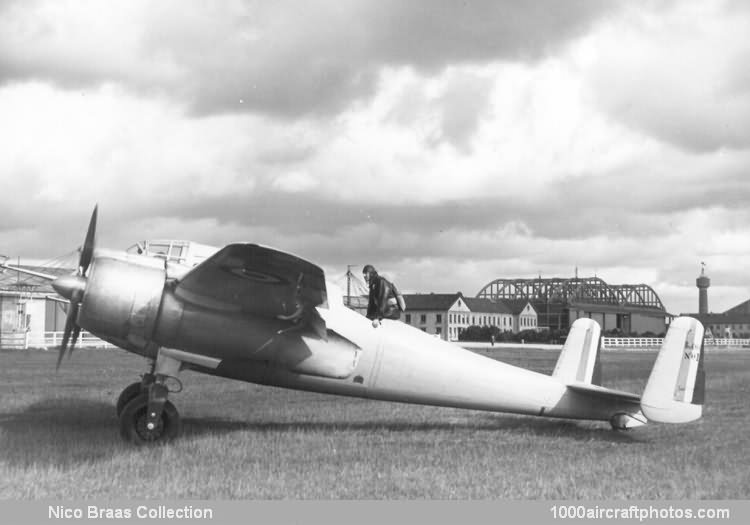04/30/2014. Remarks by Johan Visschedijk: "During the mid-1930s a resurgence of interest in the potentialities of the twin-engined two- or three-seat fighter began to manifest itself on the European continent. Such warplanes had received sporadic attention previously, but as the primary task then envisaged for the fighter, that of day interception, could be most effectively fulfilled by less expensive single-engined single-seaters, little real effort had been placed behind the development of the longer-ranging, heavier combat aircraft.
However, the history of military aviation is punctuated with developments initiated both simultaneously and spontaneously in several countries, and the heavy twin-engined fighter monoplane with multi-purpose capabilities is a case in point, for the year 1934 saw work commence in Augsburg on what was to become the Messerschmitt Bf 110 and in Amsterdam on the design th at was to emerge as the Fokker G.1, while in France, in October of that year, the Service Technique de I' Aéronautique issued a specification calling for a three-seat fighter with a fixed forward-firing cannon armament suitable for intercept, escort and fighter director roles, and which set eight French design teams working along similar lines to those being pursued by contemporaries in Germany and the Netherlands.
Specification C3 (indicating Triplace de Chasse or Three-seat Fighter) led to the construction of the Potez 630, the Hanriot 220, the Loire-Nieuport 20 and the Romano 110, but perhaps the most advanced in conception of the contestants was the Bre 690 evolved by a team headed by Georges Ricard; a sturdy and aesthetically attractive warplane which, a number of years later, was to be referred to as a lightweight forerunner of the Beaufighter.
The Bre 690, characterized by an extremely short fuselage nose, was a mid-wing cantilever monoplane. The duralumin monocoque fuselage of oval section hosted the pilot, navigator and radio-operator gunner, twin 0.787 in (20 mm) Hispano-Suiza cannon being mounted in the fuselage, one on each side of the pilot's seat, and a single 0.295 in (7.5 mm) MAC 1934 machine gun was provided on a flexible mounting in the rear cockpit.
The wing was also of all-metal construction, and comprised a torsion box with detachable leading and trailing edges and tips. Carrying metal-framed, fabric covered ailerons and pneumatically-actuated flaps, the wing halves were bolted to the two fuselage mainframes which divided the three cockpits. The tail plane was of similar construction to the wing with fabric covered movable surfaces.
Power was provided by two Hispano-Suiza 14AB 02/03 fourteen-cylinder air-cooled radials each rated at 680 hp at 11,483 ft (3,500 m) and 650 hp for take off, and driving opposite-rotating three-blade Hamilton airscrews, the 185 gal (700 l) fuel capacity being divided between two wing tanks and two tanks in the engine nacelles. The main wheels retracted aft into the engine nacelles, and the long SMG legs resulted in a marked nose-up ground angle.
Construction of the Bre 690 was initiated at Villacoublay in 1935, but it was not until March 26, 1937, when nearly complete, that the prototype was officially ordered. In the meantime, the Potez 630 had been selected to fulfill the C3 requirement, and the Service Technique was toying with the potentialities of attack aircraft, although a serious division of opinion existed within the French air staff concerning such warplanes, a strong faction continuing to expound the theories of Douhet.
While there now seemed little likelihood of an order for the Bre 690 as a fighter, its designer, Ricard, had borne in mind from the outset the possibility of his creation fulfilling alternative roles, and had already undertaken preliminary studies of a two-seat attack version. Construction of the Bre 690 was too far advanced for adaptation without seriously delaying the test program, although, in the event, owing to priority in supply of the Hispano-Suiza engines being given to Potez 630 production, it was to be ten months before a pair of these could be made available for installation in the Breguet prototype. In consequence, it was not until March 23, 1938 that Breguet's Chief Test Pilot, Maurice Claisse, took the aircraft into the air for the first time.
The Bre 690 prototype was delivered to the Centre d' Essais du Matériel Aérien (CEMA) four months later for official trials during which the prototype revealed superior performance to the Potez 630, good handling characteristics and excellent maneuverability, but the SMG oleo legs of the landing gear proved to possess inadequate strength, necessitating the return of the prototype to Breguet for modifications late in August. The Bre 690 went into production as the Bre 691 AB2 (Assaut Bombardement-Deux-Place, Two-seat Attack Bomber)."
